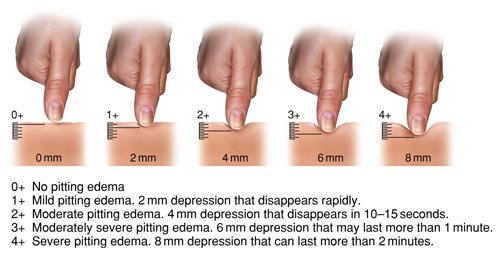The patient should be observed to gain an impression about obvious issues. Check to see whether the patient looks unwell, including facial expressions, general movement, obvious respiratory distress, body composition, skin colour, warmth and coolness of the peripheries, odour and voice.
Record vital signs including:
- Pulse: Assess rate and rhythm as well as the volume and character
- Blood pressure (BP): Assess lying as well as standing BP if the patient is symptomatic e.g, experiences dizziness or blackouts on standing
Orthostatic hypotension (or postural hypotension) is low BP that occurs when standing up from a sitting or lying position and is defined as a drop in SBP by at least 20mmHg or DBP by at least 10mmHg. Orthostatic hypotension can cause dizziness or light headedness, and may even result in fainting. It is often mild, lasting a few seconds to a few minutes after standing. However, long-lasting orthostatic hypotension can be a sign of more-serious problems which requires further investigation.
- Oxygen saturation: Determine if accompanied by dyspnoea and if this is new or worsening (a 6 minute walk test (6MWT) will identify those requiring routine oxygen saturation via pulse oximetry (SpO2) monitoring)
Additional assessments may be warranted depending on the situation, such as:
- Wound assessment for those who have recently undergone surgery
- Skin integrity for diabetics
- Sleep disturbance is frequently under recognised in patients with CVD and HF. See sleep disturbances for further information
 Pathophysiology
Pathophysiology
 Treatment & Management
Treatment & Management
 Exercise
Exercise
 Medications
Medications
 Psychosocial Issues
Psychosocial Issues
 Patient Education
Patient Education
 Behaviour Change
Behaviour Change
 Clinical Indicators
Clinical Indicators
 Pathophysiology
Pathophysiology
 Treatment & Management
Treatment & Management
 Exercise
Exercise
 Medications
Medications
 Psychosocial Issues
Psychosocial Issues
 Patient Education
Patient Education
 Behaviour Change
Behaviour Change
 Clinical Indicators
Clinical Indicators
 Pathophysiology
Pathophysiology
 Treatment & Management
Treatment & Management
 Exercise
Exercise
 Medications
Medications
 Psychosocial Issues
Psychosocial Issues
 Patient Education
Patient Education
 Behaviour Change
Behaviour Change
 Clinical Indicators
Clinical Indicators


